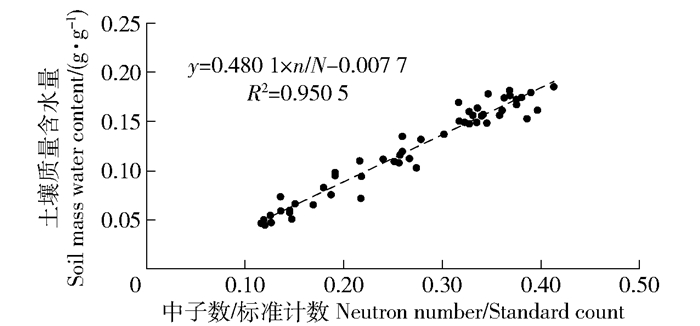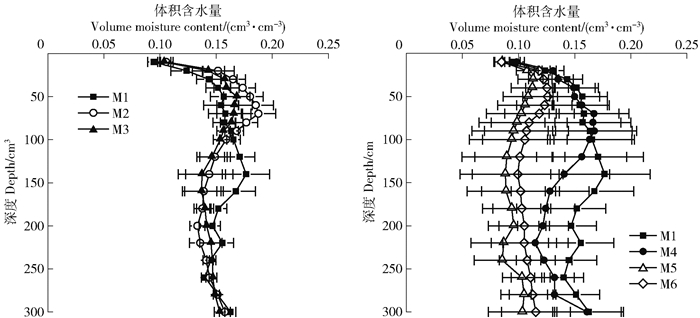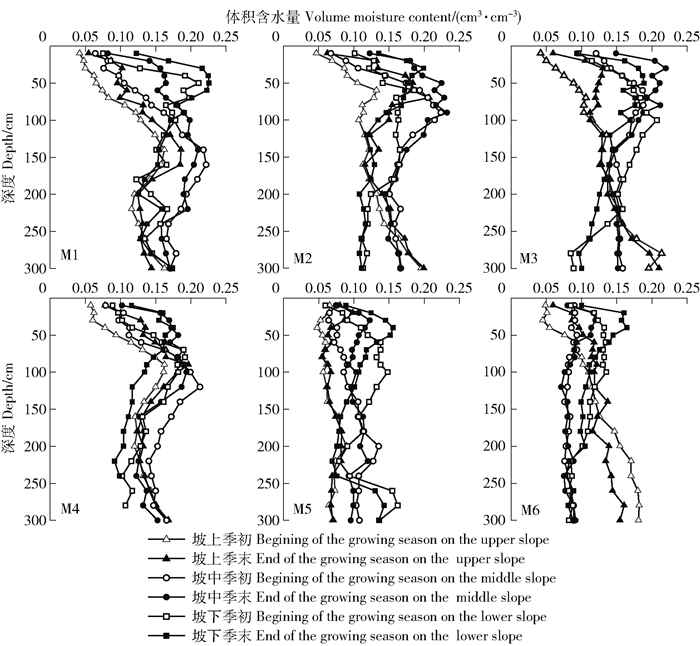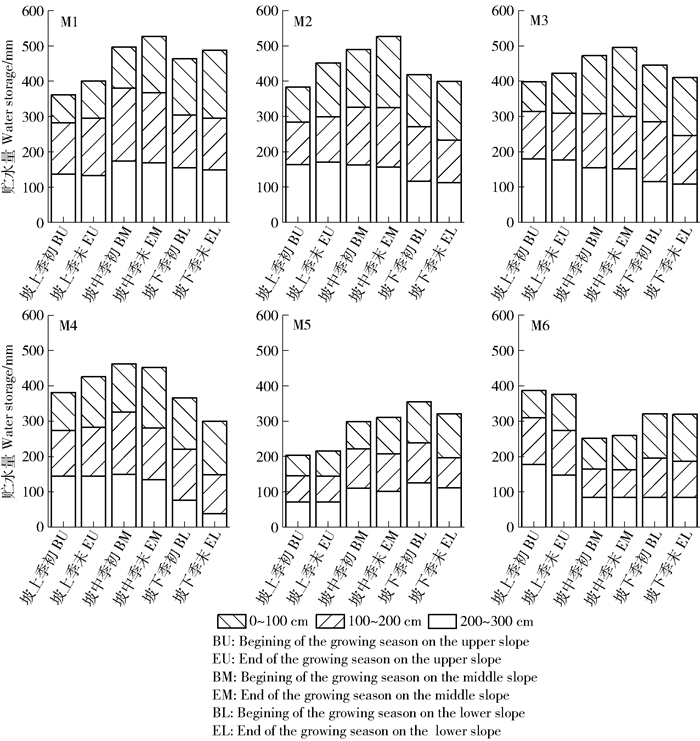-
项目名称
- 国家自然科学基金"水蚀风蚀交错区灌草植被对降雨入渗过程的影响与模拟"(41571224)
-
第一作者简介
- 张守纲(1995-), 男, 硕士研究生。主要研究方向: 土壤水循环。E-mail: zhangshougang11@163.com
-
通信作者简介
- 樊军(1974-), 男, 博士, 研究员。主要研究方向: 生态系统物质迁移。E-mail: fanjun@ms.iswc.ac.cn
-
文章历史
-
收稿日期:2020-05-20
修回日期:2021-09-04
黄土高原土地的不合理利用是该地区水土流失的主要原因;该地区地下水埋藏较深,降水是土壤水分唯一补给来源[1-2]。大面积营建水土保持植被[3],可改善生态环境,防治水土流失。不同植被类型对土壤水分的利用能力不同,黄土高原丘陵缓坡风沙区0~100 cm土层土壤含水量: 苜蓿草地>柠条林地>玉米农地,草地与林地比农地更适于涵养土壤水分[4]。黄土高原地区刺槐人工林地主要消耗80 cm土层以下的水分[3],且单纯种植乔木,严重消耗土壤水分,使土壤出现“干层”[5];由此可知,大面积营造高耗水林地,不利于水资源的合理利用及生态环境的可持续发展。多种植被配置与单一植被处理相比更有利于增加土壤水分含量,提高土壤水分高效利用, 防治土壤侵蚀[5-7]。研究显示,黄土丘陵区农林复合系统中枣树能将深层土壤水释放到表层被黄花菜和饲料油菜吸收利用[8],且植被间对于土壤水分的竞争会导致农作物的产量下降[9-10]。农林复合系统对于控制土壤退化,提高土壤资源承载力及土地生产力有重要作用[11]。
紫花苜蓿(Medicago sativa)在播种当年地表郁蔽度可接近100%,有效控制坡地土壤侵蚀、防治土壤退化 [12],苜蓿本身产量高、品质好、富含蛋白质,具有重要的生态、经济效益[13]。苜蓿地土壤酶活性最高,能够有效地提升土壤肥力条件[14],有效地促进微生物群落的发展,提高细菌群落的多样性[15], 提高土地生产力。进行多种植被配置时要明确不同植被间土壤水分利用能力差异及相互影响。研究显示:玉米地改种苜蓿后,土壤总耗水量增加20.17%[16],70 cm土层以下土壤含水量苜蓿低于长芒草地[17],苜蓿根系吸水层达10 m以下,多年连续种植会导致土层干化[18]。苜蓿与羊草间隔条播,行间距为15 cm,苜蓿实际分布比例为11%、27%、53%、100%,苜蓿27%分布比例较其他分布比例生长季土壤平均含水量增加21.4%、36.4%、51.7%[19]。与苜蓿地相比较,荒草地含水量高于生长年限接近的苜蓿地,且土壤含水量随生长年限的增加呈降低趋势[20]。了解不同比例苜蓿小区内土壤水分变化,对于黄土高原坡地水分持续利用和生态恢复具有重要意义。以往研究多为单一植被或固定区域内农林配置,对于坡面配置不同比例苜蓿牧草土壤水分状况的研究较少,为更好调节苜蓿牧草与黄土高原土壤水分持续利用之间的平衡关系,笔者通过在黄土高原水蚀风蚀交错区六道沟流域的坡面小区试验,对比相同面积小区内不同苜蓿配置比例的6个小区土壤水分的差异,旨在为黄土区坡面苜蓿种植合理配置提供理论依据,使黄土坡面土壤水分得到合理地利用。
1 研究区概况田间试验布设在陕西省神木市以西14 km处的六道沟小流域。该地区属于黄土高原向毛乌素沙漠过度、流水作用的黄土丘陵区向干燥剥蚀作用的鄂尔多斯草原过度的水蚀风蚀交错带,该流域面积6.89 km2。年均降水量为466.3 mm(2003—2019年),属于中温带半干旱气候,冬春季干旱少雨,夏秋多雨。现在主要土壤类型为沙黄土、新黄土、风沙土等[21]。坡面小区建于2006年,佘冬立等 [21]曾在该小区种植柠条林地、苜蓿草地、大豆农地,后大豆农地演变为自然撂荒。
2 材料与方法 2.1 实验处理坡面小区面积15 m×4 m,坡度为12°。每个小区埋设3根3 m长铝制中子仪测管(图 1)。撂荒地内植被优势种为长芒草(Stipa bungeana)。6种配置模式(由坡上至坡下)分别为: M1:单一撂荒处理; M2:撂荒-苜蓿(13 ∶2);M3:撂荒-苜蓿(2 ∶1);M4:撂荒-苜蓿(1 ∶1);M5:苜蓿-撂荒(1 ∶1);M6;撂荒-苜蓿(1 ∶2)。苜蓿已经种植13年,旺盛生长期冠层高度为78 cm。撂荒地为11年自然撂荒草地,各小区本年度均无坡面径流产生。2019年6—10月每月中旬采用CNC503B型中子仪测量土壤剖面体积含水量,在降雨3—5 d内入渗深度会达到较深土层,进行加测1次。笔者选取雨季初期与雨季末期即6月与10月数据,分析经过雨季作用,不同苜蓿比例小区内土壤水分变化。测量深度为0~100 cm间隔10 cm,100~300 cm间隔20 cm。试验区内布设标准雨量筒,雨后用雨量筒测量降水量。2019年6月至10月份降雨量347.1 mm,占全年总降水量81.4%,试验小区内不进行任何人为干扰,依靠降水补充土壤水分。

|
中子管安设位置Installation position of neutron tube. M1: Single abandonment treatment. M2: Abandonment : Alfalfa is 13 ∶2. M3: Abandonment : Alfalfa is 2 ∶1. M4: Abandonment: Alfalfa is 1 ∶1. M5: Alfalfa ∶Abandonment is 1 ∶1. M6: Abandonment ∶Alfalfa is 1 ∶2. The same below. 图 1 坡面不同苜蓿种植比例小区布设图 Fig. 1 Plot distribution of slopes planted with different proportions of Medicago sativa |
| $ \theta_{\mathrm{m}}=\left(m_{2}-m_{1}\right) /\left(m_{1}-m\right)。$ | (1) |
式中:θm为土壤质量含水量,g/g; m为铝盒质量, g; m1为烘干土质量,g; m2为湿土质量,g。
| $ \theta=(a n /N+b) \rho_{\mathrm{b}}。$ | (2) |
式中: θ为土壤体积含水量,cm3/cm3; a为直线斜率; n为中子仪读数; N为标准计数值,测量期间N=667;b为y轴截距; ρb为土壤密度,ρb=1.35 g/cm3。校正方程如图 2所示。

|
n: Neutron number. N: Standard count 图 2 中子仪校正曲线 Fig. 2 Correction curve of neutron instrument |
不同土层土壤贮水量计算公式:
| $ W=10 \theta H。$ | (3) |
式中: W为土壤贮水量,mm; H为土层深度,cm。
黄土高原土层深厚,地下水较深,深层土壤水分变化很小[3],坡面小区为多年生苜蓿及自然荒草地,无径流产生,因此水量平衡方程可表示为:
| $ E_{\mathrm{T}}=P-\Delta W。$ | (4) |
式中: ET为蒸散量,mm; P为降水量,mm; ΔW为土壤贮水量季初与季末的变化量,mm。
3 结果与分析 3.1 对土壤水分含量的影响雨季前后坡面不同苜蓿种植比例小区0~300 cm土层含水量分布及其变异(图 3)表明,M1小区土壤水分含量高于其他小区。不同比例苜蓿种植小区含水量随苜蓿地比例的增加逐渐减少。各小区在0~100 cm土层含水量随土层深度的增加呈上升趋势,坡面M2与M3小区中苜蓿面积较小,0~300 cm土层含水量相对较高,在100~300 cm土层含水量呈先减后增趋势。等比例配置小区中,M4小区苜蓿地位于坡下,100~300 cm土层含水量呈先减后增趋势,高于M5小区中坡上苜蓿地,且M5小区土壤含水量最低。M6小区内苜蓿地面积为三分之二,M5、M6小区在0~25 cm土层含水量有所增加,在25~300 cm土层含水量保持较低水平。单一撂荒地处理小区,坡下土壤含水量变化较大,对于小区平均土壤含水量影响较大。撂荒地、苜蓿地配置小区中,M2小区坡面平均土壤含水量最高,M6小区最低。M2小区坡面平均含水量分别比M3、M4、M6小区高3.5%、9.5%、40.2%。

|
图 3 6种配置模式小区土壤水分状况 Fig. 3 Soil moisture status of six configuration plots |
坡面不同苜蓿种植比例小区0~300 cm土层土壤含水量存在差异(图 4)。同小区内0~75 cm土层中坡上撂荒地土壤含水量低于坡下苜蓿地,且该土层撂荒地与苜蓿地土壤含水量受降雨补给有所增加。深层土壤水分被苜蓿消耗,土壤含水量在75~225 cm土层中呈下降趋势,225~300 cm土层中土壤含水量几乎无变化,由此可知苜蓿耗水深度超过了300 cm。M5小区,坡上苜蓿地含水量在0~300 cm土层几乎无变化。坡下撂荒地,50~250 cm土层土壤含水量呈下降趋势。M4小区,100~300 cm土层各个坡位均呈先下降后增加趋势。M1小区,0~100 cm土层中土壤含水量由坡顶至坡底呈上升趋势,100~300 cm土层土壤水分含量坡中最高。配置小区内降水入渗深度由坡上至坡下逐渐降低。苜蓿地降水入渗深度几乎不受坡位影响,均为50~60 cm。退耕撂荒地降水入渗深度高于苜蓿地,坡上撂荒地内降水入渗深度为100~220 cm。坡中撂荒地降水入渗深度为60~100 cm。坡下撂荒地降水入渗深度为60 cm。单一撂荒地处理(M1)小区中各坡位降水入渗深度最深,坡上降水入渗深度达250 cm,坡中降水入渗深度达120 cm,坡下降水的入渗深度达60 cm。M4小区,撂荒地与苜蓿地交界处时降水补给入渗深度为80 cm,M5小区中苜蓿地与撂荒地交界处降水入渗深度为120 cm。

|
图 4 植被配置小区土壤剖面含水量特征 Fig. 4 Moisture content characteristics of soil profile in different vegetation configuration plots |
坡面不同苜蓿种植比例小区,土壤水量平衡状况存在差异(表 1),配置小区总土壤贮水量随苜蓿地所占面积的增加而降低,M1、M2与M3小区在雨季初期土壤贮水量相近,在雨季末期,贮水量逐渐降低。贮水量的变化受到苜蓿所处小区位置的影响,在撂荒地与苜蓿地1 ∶1配置小区中,M5小区(苜蓿位于上坡)贮水量低于M4小区(苜蓿位于下坡),且M5、M4小区内贮水量在雨季后均略有降低,M5小区中贮水量最低。M1小区(单一撂荒地处理)贮水量最高。M6小区在坡面小区中苜蓿地所占比例最高,雨季前后土壤贮水量略有下降,土壤贮水量仅高于M5小区。蒸散量受贮水量变化的影响,坡面小区蒸散量顺序为:M4>M5>M6>M3>M2>M1,单一撂荒地处理小区内蒸散量最低。
| 表 1 坡面不同苜蓿种植比例小区雨季初期与雨季末期水量平衡状况 Tab. 1 Changes of water storage in slope plot at the beginning and end of rainy season |
不同苜蓿种植比例小区雨季前后土壤贮水量存在明显差异(图 5)。不同坡位0~100 cm土层贮水量有明显增长,坡下苜蓿地贮水量高于坡上撂荒地。0~300 cm土层,坡上苜蓿地贮水量增加12.4 mm,坡中苜蓿地贮水量增加8.1 mm,坡下的苜蓿地贮水量最高降低66.1 mm,最少为19.4 mm。苜蓿地位于坡上与坡中时,0~100 cm土层贮水量在雨季后均有增加,坡上增加9.8 mm,坡中增加13.2 mm。100~300 cm土层贮水量分别保持在144~145 mm和162~163 mm,使苜蓿地贮水量呈增加状态。坡上与坡中苜蓿地贮水量低于坡下苜蓿地。苜蓿地位于坡下时,0~100 cm土层贮水量保持在161~163 mm,无明显的变化。100~300 cm土层贮水量雨季后出现明显的降低,降低了39.6 mm。该坡位苜蓿地贮水量呈降低状态。苜蓿地与撂荒地相邻处土壤贮水量M4小区中贮水量降低10.6 mm,M5小区中贮水量增加11.9 mm。

|
图 5 配置小区不同土层深度贮水量差异 Fig. 5 Soil water storage difference of different soil layers in configuration plots |
多年生苜蓿根系生长较深[22],耗水量较高[23],连续大面积种植苜蓿会造成土壤水分亏缺出现土壤干层,影响苜蓿生产力和水分利用效率[13],使苜蓿地内土壤含水量处于较低水平。撂荒地内为浅根型草本植物,主要吸收浅层土壤水分为主、耗水量低,使得深层土壤含水量相对较高。深根性植物柠条与苜蓿相邻生长,会迅速耗尽土壤水分,不利于植物生长,柠条地、苜蓿地与撂荒地、农地相邻配置有利于不同土层土壤水分的利用[24]。单一撂荒地配置小区内,在0~100 cm土层中土壤水分含量由坡顶至坡底逐渐增高与佘冬立等研究结果一致,即表层土壤水分从小区上部到下部随坡长的增加而增加[21]。单一撂荒地处理小区总土壤贮水量高于撂荒地-苜蓿地配置小区,但是在黄土高原生态恢复中,坡耕地仅通过撂荒恢复的自然演替植被,不利于防治土壤侵蚀[6]和土壤水分的高效利用。人工种植一定比例的苜蓿能够有效地解决这一问题。经过整个雨季,各个配置小区不同坡位0~100 cm土层,土壤水分含量明显增加,是因为降雨入渗深度主要集中在该土层范围内,这与王云强[25]研究结果一致。而100~300 cm土层受到降水补给影响较小,土壤含水量随土层深度的增加逐渐降低。刘春利等[26]也报道在水分补偿期(4月至9月)与稳定期(10月至翌年1月),土壤含水量均随土层深度的增加而递减。撂荒地表层降水入渗量由坡上至坡下逐渐增多,可能是由于撂荒小区表层土壤密度由坡上至坡下逐渐降低,影响降水的入渗过程[27]。有研究显示苜蓿在0~100 cm土层土壤水分利用率100%,100~200 cm土壤水分利用率90%~100%,200~300 cm土壤水分利用率达95%[28],水分利用效率高于自然撂荒地。苜蓿为避免受到干旱胁迫,会促使根系吸收更深层土壤水分,减轻降雨不足的影响[5]。苜蓿地位于坡上时(图 4-M4),雨季前后50 cm以下土壤水分基本保持不变,并已接近凋萎含水量,为维持正常生理需水,苜蓿根系向侧向生长,使苜蓿地与撂荒地相邻处土壤含水量降低。当苜蓿地位于坡下时(图 4),二者相邻处土壤含水量相对较高。不同苜蓿种植比例小区,随苜蓿地所占比例的增加,土壤总贮水量降低,因为苜蓿的耗水量会随密度的增大而增大[23]。有研究显示,在坡面下部植被覆盖面积超过20%就可以有效阻止上方水土流失[21],其中图 5-M2模式土壤贮水量最高,苜蓿覆盖面积为13.3%,坡面小区已无径流产生。所以,M2配置模式更有利于防治水土流失及坡地小区内植被恢复和土壤水分的积蓄。
5 结论不同的苜蓿种植比例导致土壤水分分布存在差异,苜蓿对土壤水分的利用能力强于当地自然恢复的草地,苜蓿地位于小区坡下时,两植被相邻处土壤含水量及整个小区土壤含水量均高于苜蓿位于小区坡上。随坡地人工苜蓿地配置比例增大,小区总贮水量降低,土壤水分在自然降水作用下无法恢复。坡面植被配置应该减少高耗水植被配置的比例。撂荒地与苜蓿地配置比例为13 ∶2时坡面水土流失得到控制,且土壤水分状况良好。
| [1] |
冯金朝, 陈荷生. 宁夏沙坡头地区人工固沙植被种间水分竞争的初步研究[J]. 生态学报, 1994, 14(3): 260. FENG Jinzhao, CHEN Hesheng. Preliminary study on water competition among artificial sand-fixing vegetations in Shapotou area of Ningxia[J]. Acta Ecologica Sinica, 1994, 14(3): 260. DOI:10.3321/j.issn:1000-0933.1994.03.006 |
| [2] |
赵忠, 李剑, 袁志发, 等. 黄土沟坡刺槐林地土壤水分垂直变化的数学模型[J]. 林业科学, 2009, 45(10): 9. ZHAO Zhong, LI Jian, YUAN Zhifa, et al. A model used to describe vertical change of soil moisture of Robinia pseudoacacia plantations growing in the Loess Gully Slope[J]. Scientia Silvae Sinicae, 2009, 45(10): 9. |
| [3] |
张建军, 李慧敏, 徐佳佳. 黄土高原水土保持林对土壤水分的影响[J]. 生态学报, 2011, 31(23): 71. ZHANG Jianjun, LI Huimin, XU Jiajia. Soil moisture dynamics of water and soil conservation forest on the Loess Plateau[J]. Acta Ecologica Sinica, 2011, 31(23): 71. |
| [4] |
张敏, 刘爽, 刘勇, 等. 黄土丘陵缓坡风沙区不同土地利用类型土壤水分变化特征[J]. 水土保持学报, 2019, 33(3): 115. ZHANG Min, LIU Shuang, LIU Yong, et al. Soil moisture variation characteristics of different land use types in the moderate slope sandy area of Loess Hilly Region[J]. Journal of Soil and Water Conservation, 2019, 33(3): 115. |
| [5] |
朝鲁蒙, 王进鑫, 侯琳, 等. 黄土高原不同植被复合边界土壤水分分布及影响域研究[J]. 中国水土保持科学, 2007, 5(3): 28. CHAO Lumeng, WANG Jinxin, HOU Lin, et al. Distribution of soil water and distance of edge influence at different vegetation compound boundary[J]. Science of Soil and Water Conservation, 2007, 5(3): 28. DOI:10.3969/j.issn.1672-3007.2007.03.006 |
| [6] |
佘冬立, 邵明安, 俞双恩. 黄土高原水蚀风蚀交错带小流域土壤矿质氮空间变异性[J]. 农业工程学报, 2010, 26(6): 89. SHE Dongli, SHAO Mingan, YU Shuangen. Spatial variability of soil mineral nitrogen in a small catchment in the wind-water erosion crisscross zone of Loess Plateau[J]. Transactions of the CSAE, 2010, 26(6): 89. DOI:10.3969/j.issn.1002-6819.2010.06.016 |
| [7] |
王国梁, 刘国彬, 党小虎. 黄土丘陵区不同土地利用方式对土壤含水率的影响[J]. 农业工程学报, 2009, 25(2): 31. WANG Guoliang, LIU Guobin, DANG Xiaohu. Effects of land use on soil moisture in loess hilly and gully region of China[J]. Transactions of the CSAE, 2009, 25(2): 31. |
| [8] |
霍高鹏, 赵西宁, 高晓东, 等. 黄土丘陵区枣农复合系统土壤水分利用与竞争[J]. 自然资源学报, 2017, 32(12): 2043. HUO Gaopeng, ZHAO Xining, GAO Xiaodong, et al. Soil water use and competition in jujube-crop systems in Loess Hilly Region[J]. Journal of Natural Resources, 2017, 32(12): 2043. DOI:10.11849/zrzyxb.20161101 |
| [9] |
GILLESPIE A R, JOSE S, MENGEL D B, et al. Defining competition vectors in a temperate alley cropping system in the Midwestern USA: 1. Production physiology[J]. Agroforestry Systems, 2000(48): 25. |
| [10] |
HOU Q, BRANDLE J, HUBBARD K, et al. Alteration of soil water content consequent to root-pruning at a windbreak/crop interface in Nebraska USA[J]. Agroforestry Systems, 2003(57): 137. |
| [11] |
唐夫凯, 齐丹卉, 卢琦, 等. 中国西北地区农林复合经营的保护与发展[J]. 自然资源学报, 2016, 31(9): 1429. TANG Fukai, QI Danhui, LU Qi, et al. Strategies of conservation and development of agroforestry ecosystem in Northwest China[J]. Journal of Natural Resources, 2016, 31(9): 1429. |
| [12] |
李裕元, 邵明安. 黄土高原北部紫花苜蓿草地退化过程与植物多样性研究[J]. 应用生态学报, 2005, 16(12): 2321. LI Yuyuan, SHAO Mingan. Degradation process and plant diversity of alfalfa grassland in North Loess Plateau of China[J]. Chinese Journal of Applied Ecology, 2005, 16(12): 2321. DOI:10.3321/j.issn:1001-9332.2005.12.019 |
| [13] |
谢军红, 柴强, 张仁陟, 等. 黄土高原区多年生苜蓿地土壤干层恢复的适宜后茬筛选[J]. 水土保持学报, 2014, 28(5): 51. XIE Junhong, CHAI Qiang, ZHANG Renzhi, et al. Suitable succession crop screening after perennial alfalfa for soil dedication restoration in Loess Plateau[J]. Journal of Soil and Water Conservation, 2014, 28(5): 51. |
| [14] |
韩国君, 何明珠, 黄海霞, 等. 黄土高原种植不同人工牧草对土壤酶活性的影响[J]. 水土保持通报, 2019, 39(3): 19. HAN Guojun, HE Mingzhu, HUANG Haixia, et al. Effects of different forage varieties on soil enzyme activities in Loess Plateau[J]. Bulletin of Soil and Water Conservation, 2019, 39(3): 19. |
| [15] |
耿德洲, 黄菁华, 霍娜, 等. 黄土高原半干旱区不同种植年限紫花苜蓿人工草地土壤微生物和线虫群落特征[J]. 应用生态学报, 2020, 31(4): 1365. GENG Dezhou, HUANG Jinghua, HUO Na, et al. Characteristics of soil microbial and nematode communities under artificial medicago sativa grasslands with different cultivation years in semi-arid region of Loess Plateau, Northwest China[J]. Chinese Journal of Applied Ecology, 2020, 31(4): 1365. |
| [16] |
田德龙, 侯晨丽, 徐冰, 等. 苜蓿对农田耗水过程与盐分变化的影响[J]. 农业机械学报, 2019, 50(7): 291. TIAN Delong, HOU Chenli, XU Bing, et al. Effect of Alfalfa on Water Consumption Process and Salt Changes in Fields[J]. Transactions of the CSAM, 2019, 50(7): 291. |
| [17] |
冯博, 贾小旭, 于冬雪, 等. 黄土高原北部草地土壤水分空间变异研究[J]. 土壤通报, 2019, 50(5): 1123. FENG Bo, JIA Xiaoxu, YU Dongxue, et al. Spatial variability of soil moisture in northern grassland of the loess plateau[J]. Chinese Journal of Soil Science, 2019, 50(5): 1123. |
| [18] |
李玉山. 苜蓿生产力动态及其水分生态环境效应[J]. 土壤学报, 2002, 39(3): 404. LI Yushan. Productivity dynamic of alfalfa and its effects on water eco-environment[J]. Acta Pedologica Sinica, 2002, 39(3): 404. DOI:10.3321/j.issn:0564-3929.2002.03.016 |
| [19] |
李强, 黄迎新, 钟荣珍, 等. 豆-禾混播草地中紫花苜蓿比例对其固氮效率的影响及潜在生理机制[J]. 中国农业科学, 2020, 53(13): 2647. LI Qiang, HUANG Yingxin, ZHONG Rongzhen, et al. Influence of Medicago sativa proportion on its individual nitrogen fixation efficiency and underlying physiological mechanism in legume-grass mixture grassland[J]. Scientia Agricultura Sinica, 2020, 53(13): 2647. DOI:10.3864/j.issn.0578-1752.2020.13.013 |
| [20] |
王亚飞, 樊军, 贾沐霖. 黄土高原水蚀风蚀交错区植被恢复中土壤水分变化[J]. 草地学报, 2016, 24(2): 344. WANG Yafei, FAN Jun, JIA Mulin. Variation of soil water content during vegetation restoration in the water-wind erosion crisscross region on the Loess Plateau[J]. Acta Agrestia Sinica, 2016, 24(2): 344. |
| [21] |
佘冬立, 邵明安, 薛亚锋, 等. 坡面土地利用格局变化的水土保持效应[J]. 农业工程学报, 2011, 27(4): 22. SHE Dongli, SHAO Mingan, XUE Yafeng, et al. Soil-water conservation effects of slope land use pattern changes[J]. Transactions of the CSAE, 2011, 27(4): 22. DOI:10.3969/j.issn.1002-6819.2011.04.005 |
| [22] |
孙洪仁, 武瑞鑫, 李品红, 等. 紫花苜蓿根系入土深度[J]. 草地学报, 2008, 16(3): 307. SUN Hongren, WU Ruixin, LI Pinhong, et al. Rooting depth of alfalfa[J]. Acta Agrestia Sinica, 2008, 16(3): 307. |
| [23] |
张晓红, 王惠梅, 徐炳成, 等. 黄土塬区3种豆科牧草对土壤水分的消耗利用研究[J]. 西北植物学报, 2007, 27(7): 1428. ZHANG Xiaohong, WANG Huimei, XU Bingcheng, et al. Soil water using and consume of three legumes on highland of Loess Plateau[J]. Acta Botanica Boreali-Occidentalia Sinica, 2007, 27(7): 1428. DOI:10.3321/j.issn:1000-4025.2007.07.024 |
| [24] |
乔艳琴, 樊军, 高宇, 等. 黄土高原水蚀风蚀交错区植被间土壤水分竞争[J]. 自然资源学报, 2014, 29(5): 801. QIAO Yanqin, FAN Jun, GAO Yu, et al. Competition for soil moisture between different vegetation types in the water and wind crisscross region of the Loess Plateau[J]. Journal of Natural Resources, 2014, 29(5): 801. |
| [25] |
王云强. 黄土高原地区土壤干层的空间分布与影响因素[D]. 陕西杨凌: 中国科学院研究生院(教育部水土保持与生态环境研究中心), 2010: 52. WANG Yunqiang. Spatial distribution and Influence factors of dried soil layers across the Loess Plateau[D]. Yangling, Shaanxi: Graduate School of the Chinese Academy of Sciences (Research Center for Soil and Water Conservation and Ecological Environment, Ministry of Education), 2010: 52. |
| [26] |
刘春利, 邵明安. 黄土高原六道沟流域不同土地利用方式下土壤水力特性及其对土壤水分的影响[J]. 应用生态学报, 2008, 19(11): 2400. LIU Chunli, SHAO Mingan. Soil hydraulic properties and their influences on soil water content under different land uses in Liudaogou watershed of Loess Plateau[J]. Chinese Journal of Applied Ecology, 2008, 19(11): 2400. |
| [27] |
佘冬立. 黄土高原水蚀风蚀交错带小流域植被恢复的水土环境效应研究[D]. 陕西杨凌: 中国科学院研究生院(教育部水土保持与生态环境研究中心), 2009: 85. SHE Dongli. Soil-water Environmental Effects of Revegetation in a sall catchment in the Wind-water Erosion Crisscross Zone of the Loess Plateau[D]. Yangling, Shaanxi: Graduate University of Chinese Academy of Sciences(Soil and Water Conservation and Ecological Environment Research Center of ministry of Education), 2009: 85. |
| [28] |
徐炳成, 山仑, 陈云明. 黄土高原半干旱区植被建设的土壤水分效应及其影响因素[J]. 中国水土保持科学, 2003, 1(4): 32. XU Bingcheng, SHAN Lun, CHEN Yunming. Review and discuss on the effect and influence factors of vegetation construction on soil water in semi-area on Loess Plateau[J]. Science of Soil and Water Conservation, 2003, 1(4): 32. DOI:10.3969/j.issn.1672-3007.2003.04.008 |
 2021, Vol. 19
2021, Vol. 19 
